Literature Review: Design Optimization of Rotary Compressors Analysis
VerifiedAdded on 2023/01/19
|21
|5867
|48
Report
AI Summary
This report provides a comprehensive literature review on the design optimization of rotary compressors, covering various aspects from valve dynamics to thermodynamic analysis. It examines mathematical models for air and refrigeration compressors, including those used in gas turbines and heat pumps. The review explores the dynamic behavior of compressor valves, including reed valves, and their impact on performance. It also delves into different modeling approaches, such as those based on control volumes and polytropic processes, and discusses the influence of parameters like friction factors, mass flow rates, and refrigerant properties. The report highlights the importance of model validation through experimental data and discusses the limitations of existing models, providing insights into potential areas for future research and development in the field of rotary compressor design.

DESIGN OPTIMIZATION OF ROTARY COMPRESSORS
Literature review
Literature reviews has been carried out in the present work from the valve as dynamics as well as
thermodynamics points of view. A significant amount of work has been done in literature for the
rotary compressors in which some of the work has been published on the analysis of
reciprocating compressors as well as refrigeration rotary using simple mathematical models.
Model for air compressors
A mathematical model for a rotary compressor adopted in gas turbines power plants was
invented by Venturini (2005) that was used in compressor dynamic simulation. Implementation
of the model was done using MATLAB SIMULAINK tool upon the development of the
compressor mathematical model via physical based approach that was inclusive of the law of
thermal balances as well as conservation (Chung et al., 2016). The influence of the parameters of
the model was evaluated through activity analysis on the response of the model. The model was
finally formulated for a multistage centrifugal compressor that was small in size and validated
via experimental data that was take on the compressor that was under study. The analysis
indicated that:
The outlet compressor pressure is significantly influenced by the friction factor of the
exhaust duct
The inlet compressor pressure as well as the mass flow rate is mainly affected by intake
duct friction
An increase in the hydraulic mean of the exhaust duct diameter permits a greater rate of
mass flow while outlet compressor pressure as well as the inlet compressor pressure
Literature review
Literature reviews has been carried out in the present work from the valve as dynamics as well as
thermodynamics points of view. A significant amount of work has been done in literature for the
rotary compressors in which some of the work has been published on the analysis of
reciprocating compressors as well as refrigeration rotary using simple mathematical models.
Model for air compressors
A mathematical model for a rotary compressor adopted in gas turbines power plants was
invented by Venturini (2005) that was used in compressor dynamic simulation. Implementation
of the model was done using MATLAB SIMULAINK tool upon the development of the
compressor mathematical model via physical based approach that was inclusive of the law of
thermal balances as well as conservation (Chung et al., 2016). The influence of the parameters of
the model was evaluated through activity analysis on the response of the model. The model was
finally formulated for a multistage centrifugal compressor that was small in size and validated
via experimental data that was take on the compressor that was under study. The analysis
indicated that:
The outlet compressor pressure is significantly influenced by the friction factor of the
exhaust duct
The inlet compressor pressure as well as the mass flow rate is mainly affected by intake
duct friction
An increase in the hydraulic mean of the exhaust duct diameter permits a greater rate of
mass flow while outlet compressor pressure as well as the inlet compressor pressure
Paraphrase This Document
Need a fresh take? Get an instant paraphrase of this document with our AI Paraphraser
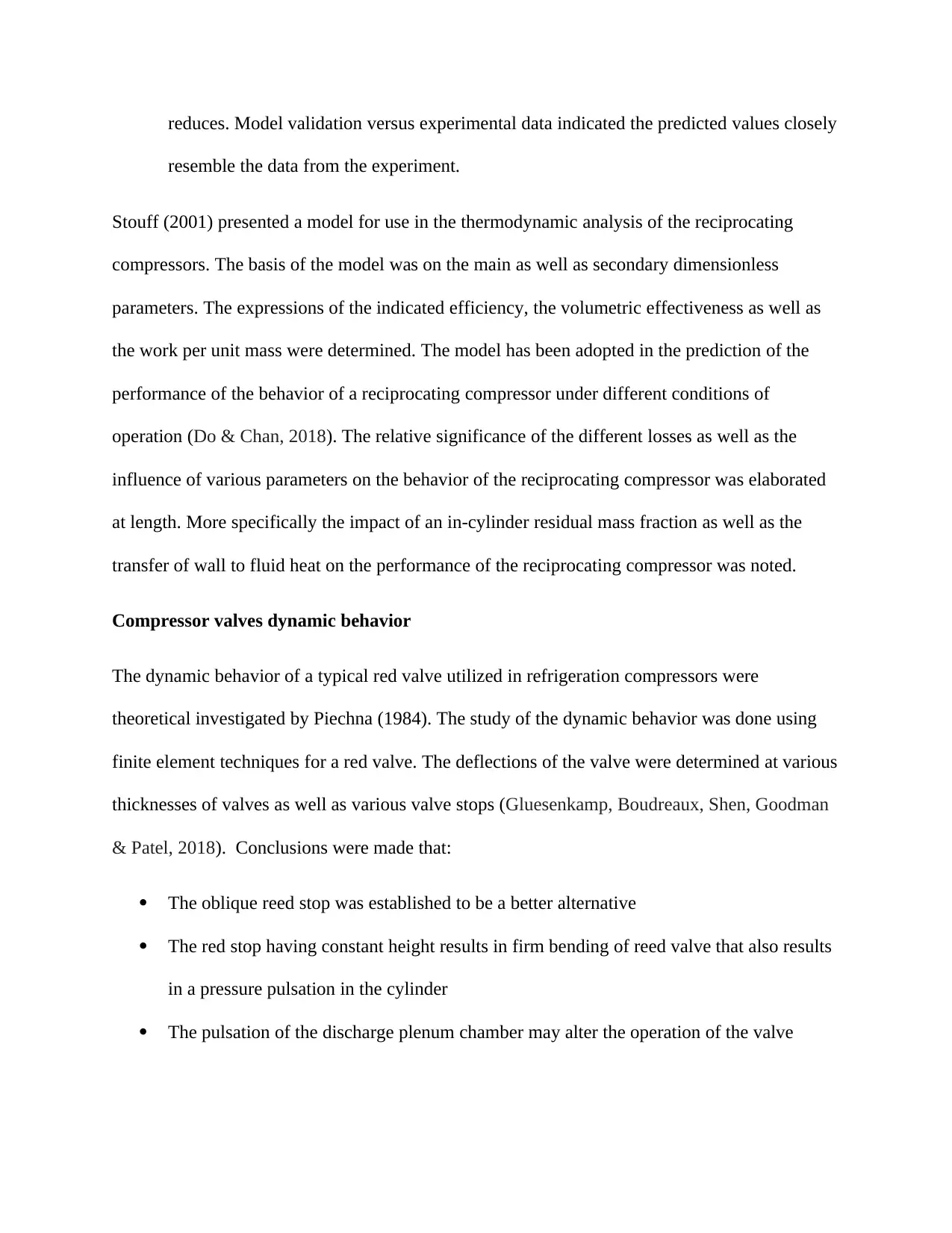
reduces. Model validation versus experimental data indicated the predicted values closely
resemble the data from the experiment.
Stouff (2001) presented a model for use in the thermodynamic analysis of the reciprocating
compressors. The basis of the model was on the main as well as secondary dimensionless
parameters. The expressions of the indicated efficiency, the volumetric effectiveness as well as
the work per unit mass were determined. The model has been adopted in the prediction of the
performance of the behavior of a reciprocating compressor under different conditions of
operation (Do & Chan, 2018). The relative significance of the different losses as well as the
influence of various parameters on the behavior of the reciprocating compressor was elaborated
at length. More specifically the impact of an in-cylinder residual mass fraction as well as the
transfer of wall to fluid heat on the performance of the reciprocating compressor was noted.
Compressor valves dynamic behavior
The dynamic behavior of a typical red valve utilized in refrigeration compressors were
theoretical investigated by Piechna (1984). The study of the dynamic behavior was done using
finite element techniques for a red valve. The deflections of the valve were determined at various
thicknesses of valves as well as various valve stops (Gluesenkamp, Boudreaux, Shen, Goodman
& Patel, 2018). Conclusions were made that:
The oblique reed stop was established to be a better alternative
The red stop having constant height results in firm bending of reed valve that also results
in a pressure pulsation in the cylinder
The pulsation of the discharge plenum chamber may alter the operation of the valve
resemble the data from the experiment.
Stouff (2001) presented a model for use in the thermodynamic analysis of the reciprocating
compressors. The basis of the model was on the main as well as secondary dimensionless
parameters. The expressions of the indicated efficiency, the volumetric effectiveness as well as
the work per unit mass were determined. The model has been adopted in the prediction of the
performance of the behavior of a reciprocating compressor under different conditions of
operation (Do & Chan, 2018). The relative significance of the different losses as well as the
influence of various parameters on the behavior of the reciprocating compressor was elaborated
at length. More specifically the impact of an in-cylinder residual mass fraction as well as the
transfer of wall to fluid heat on the performance of the reciprocating compressor was noted.
Compressor valves dynamic behavior
The dynamic behavior of a typical red valve utilized in refrigeration compressors were
theoretical investigated by Piechna (1984). The study of the dynamic behavior was done using
finite element techniques for a red valve. The deflections of the valve were determined at various
thicknesses of valves as well as various valve stops (Gluesenkamp, Boudreaux, Shen, Goodman
& Patel, 2018). Conclusions were made that:
The oblique reed stop was established to be a better alternative
The red stop having constant height results in firm bending of reed valve that also results
in a pressure pulsation in the cylinder
The pulsation of the discharge plenum chamber may alter the operation of the valve
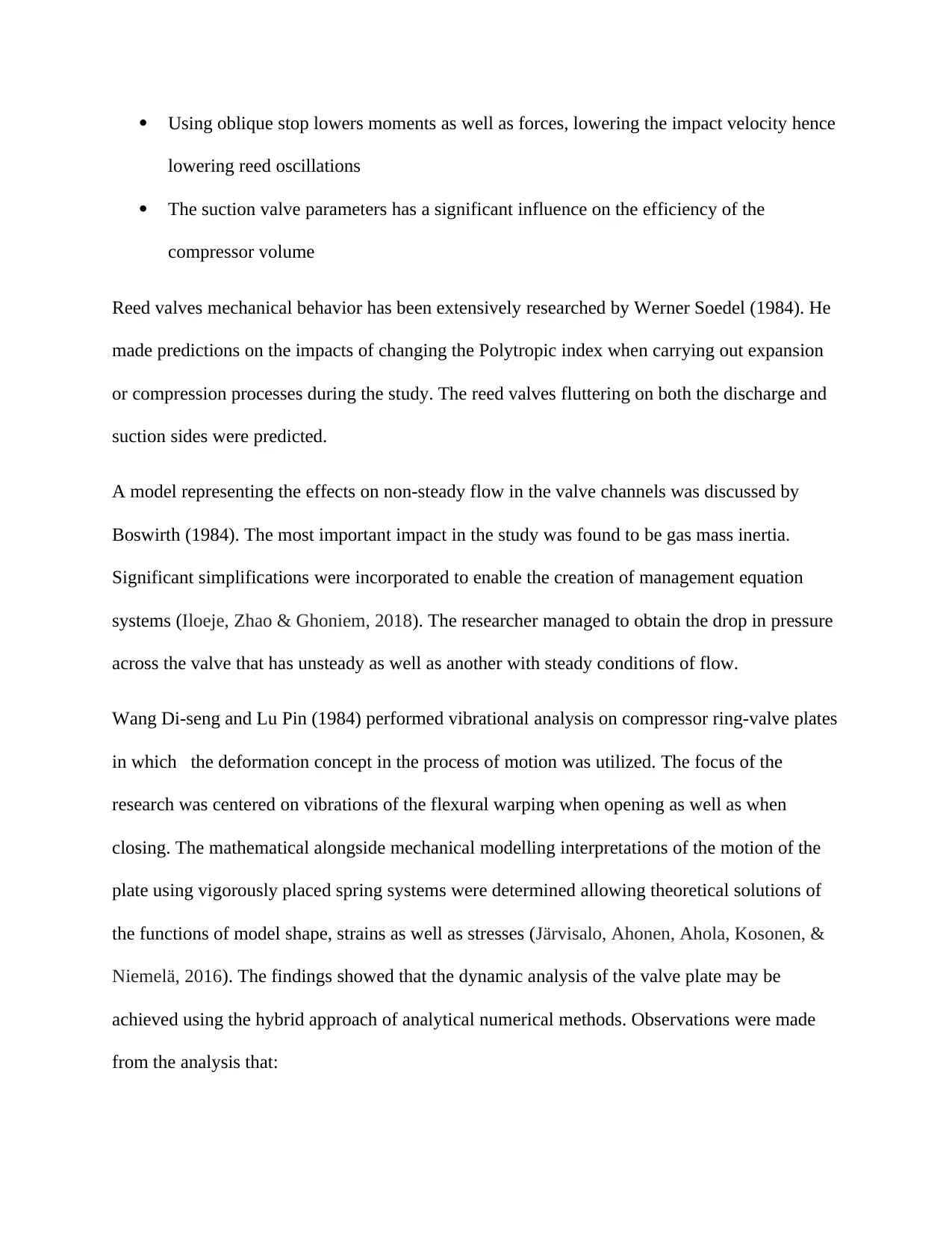
Using oblique stop lowers moments as well as forces, lowering the impact velocity hence
lowering reed oscillations
The suction valve parameters has a significant influence on the efficiency of the
compressor volume
Reed valves mechanical behavior has been extensively researched by Werner Soedel (1984). He
made predictions on the impacts of changing the Polytropic index when carrying out expansion
or compression processes during the study. The reed valves fluttering on both the discharge and
suction sides were predicted.
A model representing the effects on non-steady flow in the valve channels was discussed by
Boswirth (1984). The most important impact in the study was found to be gas mass inertia.
Significant simplifications were incorporated to enable the creation of management equation
systems (Iloeje, Zhao & Ghoniem, 2018). The researcher managed to obtain the drop in pressure
across the valve that has unsteady as well as another with steady conditions of flow.
Wang Di-seng and Lu Pin (1984) performed vibrational analysis on compressor ring-valve plates
in which the deformation concept in the process of motion was utilized. The focus of the
research was centered on vibrations of the flexural warping when opening as well as when
closing. The mathematical alongside mechanical modelling interpretations of the motion of the
plate using vigorously placed spring systems were determined allowing theoretical solutions of
the functions of model shape, strains as well as stresses (Järvisalo, Ahonen, Ahola, Kosonen, &
Niemelä, 2016). The findings showed that the dynamic analysis of the valve plate may be
achieved using the hybrid approach of analytical numerical methods. Observations were made
from the analysis that:
lowering reed oscillations
The suction valve parameters has a significant influence on the efficiency of the
compressor volume
Reed valves mechanical behavior has been extensively researched by Werner Soedel (1984). He
made predictions on the impacts of changing the Polytropic index when carrying out expansion
or compression processes during the study. The reed valves fluttering on both the discharge and
suction sides were predicted.
A model representing the effects on non-steady flow in the valve channels was discussed by
Boswirth (1984). The most important impact in the study was found to be gas mass inertia.
Significant simplifications were incorporated to enable the creation of management equation
systems (Iloeje, Zhao & Ghoniem, 2018). The researcher managed to obtain the drop in pressure
across the valve that has unsteady as well as another with steady conditions of flow.
Wang Di-seng and Lu Pin (1984) performed vibrational analysis on compressor ring-valve plates
in which the deformation concept in the process of motion was utilized. The focus of the
research was centered on vibrations of the flexural warping when opening as well as when
closing. The mathematical alongside mechanical modelling interpretations of the motion of the
plate using vigorously placed spring systems were determined allowing theoretical solutions of
the functions of model shape, strains as well as stresses (Järvisalo, Ahonen, Ahola, Kosonen, &
Niemelä, 2016). The findings showed that the dynamic analysis of the valve plate may be
achieved using the hybrid approach of analytical numerical methods. Observations were made
from the analysis that:
⊘ This is a preview!⊘
Do you want full access?
Subscribe today to unlock all pages.

Trusted by 1+ million students worldwide
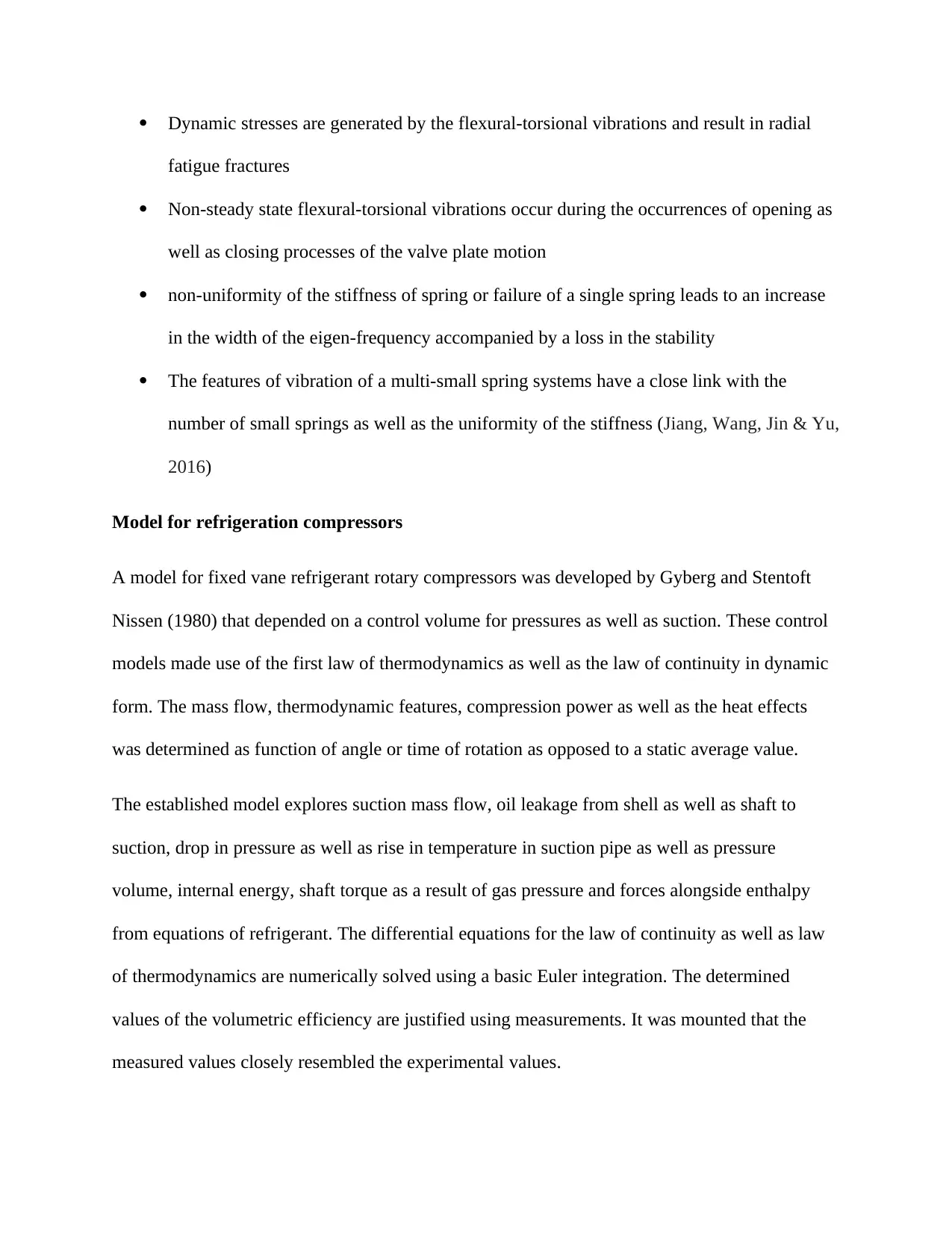
Dynamic stresses are generated by the flexural-torsional vibrations and result in radial
fatigue fractures
Non-steady state flexural-torsional vibrations occur during the occurrences of opening as
well as closing processes of the valve plate motion
non-uniformity of the stiffness of spring or failure of a single spring leads to an increase
in the width of the eigen-frequency accompanied by a loss in the stability
The features of vibration of a multi-small spring systems have a close link with the
number of small springs as well as the uniformity of the stiffness (Jiang, Wang, Jin & Yu,
2016)
Model for refrigeration compressors
A model for fixed vane refrigerant rotary compressors was developed by Gyberg and Stentoft
Nissen (1980) that depended on a control volume for pressures as well as suction. These control
models made use of the first law of thermodynamics as well as the law of continuity in dynamic
form. The mass flow, thermodynamic features, compression power as well as the heat effects
was determined as function of angle or time of rotation as opposed to a static average value.
The established model explores suction mass flow, oil leakage from shell as well as shaft to
suction, drop in pressure as well as rise in temperature in suction pipe as well as pressure
volume, internal energy, shaft torque as a result of gas pressure and forces alongside enthalpy
from equations of refrigerant. The differential equations for the law of continuity as well as law
of thermodynamics are numerically solved using a basic Euler integration. The determined
values of the volumetric efficiency are justified using measurements. It was mounted that the
measured values closely resembled the experimental values.
fatigue fractures
Non-steady state flexural-torsional vibrations occur during the occurrences of opening as
well as closing processes of the valve plate motion
non-uniformity of the stiffness of spring or failure of a single spring leads to an increase
in the width of the eigen-frequency accompanied by a loss in the stability
The features of vibration of a multi-small spring systems have a close link with the
number of small springs as well as the uniformity of the stiffness (Jiang, Wang, Jin & Yu,
2016)
Model for refrigeration compressors
A model for fixed vane refrigerant rotary compressors was developed by Gyberg and Stentoft
Nissen (1980) that depended on a control volume for pressures as well as suction. These control
models made use of the first law of thermodynamics as well as the law of continuity in dynamic
form. The mass flow, thermodynamic features, compression power as well as the heat effects
was determined as function of angle or time of rotation as opposed to a static average value.
The established model explores suction mass flow, oil leakage from shell as well as shaft to
suction, drop in pressure as well as rise in temperature in suction pipe as well as pressure
volume, internal energy, shaft torque as a result of gas pressure and forces alongside enthalpy
from equations of refrigerant. The differential equations for the law of continuity as well as law
of thermodynamics are numerically solved using a basic Euler integration. The determined
values of the volumetric efficiency are justified using measurements. It was mounted that the
measured values closely resembled the experimental values.
Paraphrase This Document
Need a fresh take? Get an instant paraphrase of this document with our AI Paraphraser
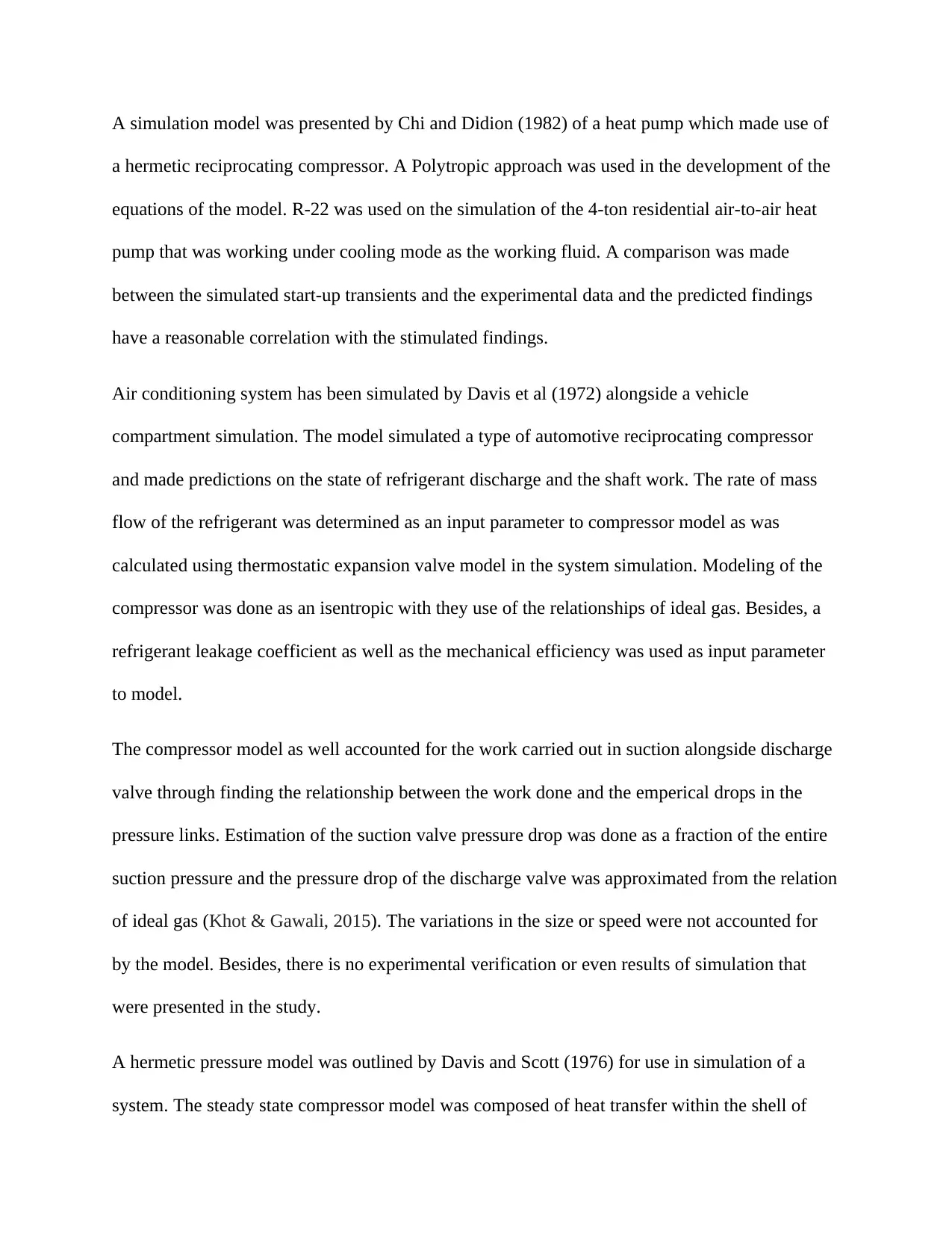
A simulation model was presented by Chi and Didion (1982) of a heat pump which made use of
a hermetic reciprocating compressor. A Polytropic approach was used in the development of the
equations of the model. R-22 was used on the simulation of the 4-ton residential air-to-air heat
pump that was working under cooling mode as the working fluid. A comparison was made
between the simulated start-up transients and the experimental data and the predicted findings
have a reasonable correlation with the stimulated findings.
Air conditioning system has been simulated by Davis et al (1972) alongside a vehicle
compartment simulation. The model simulated a type of automotive reciprocating compressor
and made predictions on the state of refrigerant discharge and the shaft work. The rate of mass
flow of the refrigerant was determined as an input parameter to compressor model as was
calculated using thermostatic expansion valve model in the system simulation. Modeling of the
compressor was done as an isentropic with they use of the relationships of ideal gas. Besides, a
refrigerant leakage coefficient as well as the mechanical efficiency was used as input parameter
to model.
The compressor model as well accounted for the work carried out in suction alongside discharge
valve through finding the relationship between the work done and the emperical drops in the
pressure links. Estimation of the suction valve pressure drop was done as a fraction of the entire
suction pressure and the pressure drop of the discharge valve was approximated from the relation
of ideal gas (Khot & Gawali, 2015). The variations in the size or speed were not accounted for
by the model. Besides, there is no experimental verification or even results of simulation that
were presented in the study.
A hermetic pressure model was outlined by Davis and Scott (1976) for use in simulation of a
system. The steady state compressor model was composed of heat transfer within the shell of
a hermetic reciprocating compressor. A Polytropic approach was used in the development of the
equations of the model. R-22 was used on the simulation of the 4-ton residential air-to-air heat
pump that was working under cooling mode as the working fluid. A comparison was made
between the simulated start-up transients and the experimental data and the predicted findings
have a reasonable correlation with the stimulated findings.
Air conditioning system has been simulated by Davis et al (1972) alongside a vehicle
compartment simulation. The model simulated a type of automotive reciprocating compressor
and made predictions on the state of refrigerant discharge and the shaft work. The rate of mass
flow of the refrigerant was determined as an input parameter to compressor model as was
calculated using thermostatic expansion valve model in the system simulation. Modeling of the
compressor was done as an isentropic with they use of the relationships of ideal gas. Besides, a
refrigerant leakage coefficient as well as the mechanical efficiency was used as input parameter
to model.
The compressor model as well accounted for the work carried out in suction alongside discharge
valve through finding the relationship between the work done and the emperical drops in the
pressure links. Estimation of the suction valve pressure drop was done as a fraction of the entire
suction pressure and the pressure drop of the discharge valve was approximated from the relation
of ideal gas (Khot & Gawali, 2015). The variations in the size or speed were not accounted for
by the model. Besides, there is no experimental verification or even results of simulation that
were presented in the study.
A hermetic pressure model was outlined by Davis and Scott (1976) for use in simulation of a
system. The steady state compressor model was composed of heat transfer within the shell of
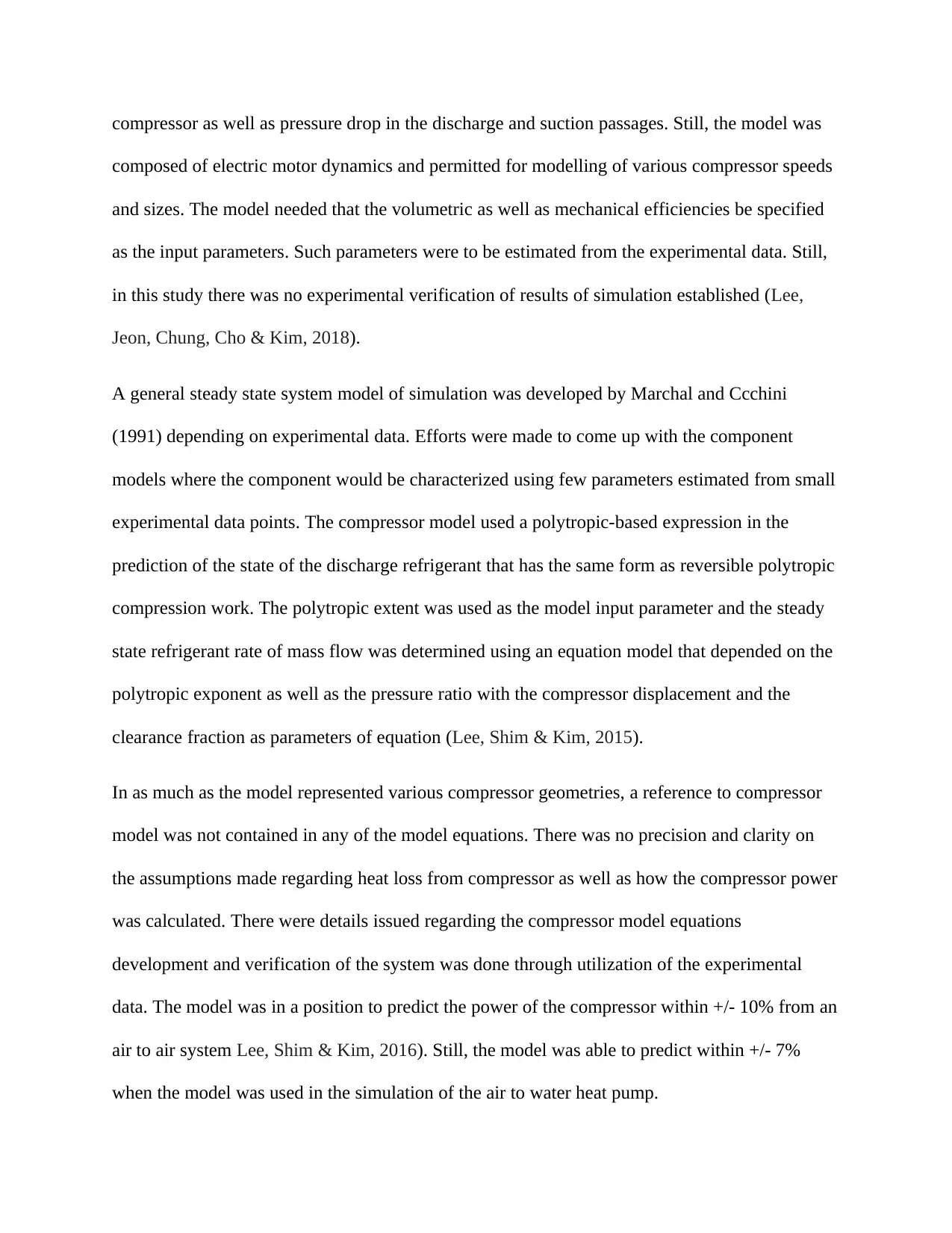
compressor as well as pressure drop in the discharge and suction passages. Still, the model was
composed of electric motor dynamics and permitted for modelling of various compressor speeds
and sizes. The model needed that the volumetric as well as mechanical efficiencies be specified
as the input parameters. Such parameters were to be estimated from the experimental data. Still,
in this study there was no experimental verification of results of simulation established (Lee,
Jeon, Chung, Cho & Kim, 2018).
A general steady state system model of simulation was developed by Marchal and Ccchini
(1991) depending on experimental data. Efforts were made to come up with the component
models where the component would be characterized using few parameters estimated from small
experimental data points. The compressor model used a polytropic-based expression in the
prediction of the state of the discharge refrigerant that has the same form as reversible polytropic
compression work. The polytropic extent was used as the model input parameter and the steady
state refrigerant rate of mass flow was determined using an equation model that depended on the
polytropic exponent as well as the pressure ratio with the compressor displacement and the
clearance fraction as parameters of equation (Lee, Shim & Kim, 2015).
In as much as the model represented various compressor geometries, a reference to compressor
model was not contained in any of the model equations. There was no precision and clarity on
the assumptions made regarding heat loss from compressor as well as how the compressor power
was calculated. There were details issued regarding the compressor model equations
development and verification of the system was done through utilization of the experimental
data. The model was in a position to predict the power of the compressor within +/- 10% from an
air to air system Lee, Shim & Kim, 2016). Still, the model was able to predict within +/- 7%
when the model was used in the simulation of the air to water heat pump.
composed of electric motor dynamics and permitted for modelling of various compressor speeds
and sizes. The model needed that the volumetric as well as mechanical efficiencies be specified
as the input parameters. Such parameters were to be estimated from the experimental data. Still,
in this study there was no experimental verification of results of simulation established (Lee,
Jeon, Chung, Cho & Kim, 2018).
A general steady state system model of simulation was developed by Marchal and Ccchini
(1991) depending on experimental data. Efforts were made to come up with the component
models where the component would be characterized using few parameters estimated from small
experimental data points. The compressor model used a polytropic-based expression in the
prediction of the state of the discharge refrigerant that has the same form as reversible polytropic
compression work. The polytropic extent was used as the model input parameter and the steady
state refrigerant rate of mass flow was determined using an equation model that depended on the
polytropic exponent as well as the pressure ratio with the compressor displacement and the
clearance fraction as parameters of equation (Lee, Shim & Kim, 2015).
In as much as the model represented various compressor geometries, a reference to compressor
model was not contained in any of the model equations. There was no precision and clarity on
the assumptions made regarding heat loss from compressor as well as how the compressor power
was calculated. There were details issued regarding the compressor model equations
development and verification of the system was done through utilization of the experimental
data. The model was in a position to predict the power of the compressor within +/- 10% from an
air to air system Lee, Shim & Kim, 2016). Still, the model was able to predict within +/- 7%
when the model was used in the simulation of the air to water heat pump.
⊘ This is a preview!⊘
Do you want full access?
Subscribe today to unlock all pages.

Trusted by 1+ million students worldwide
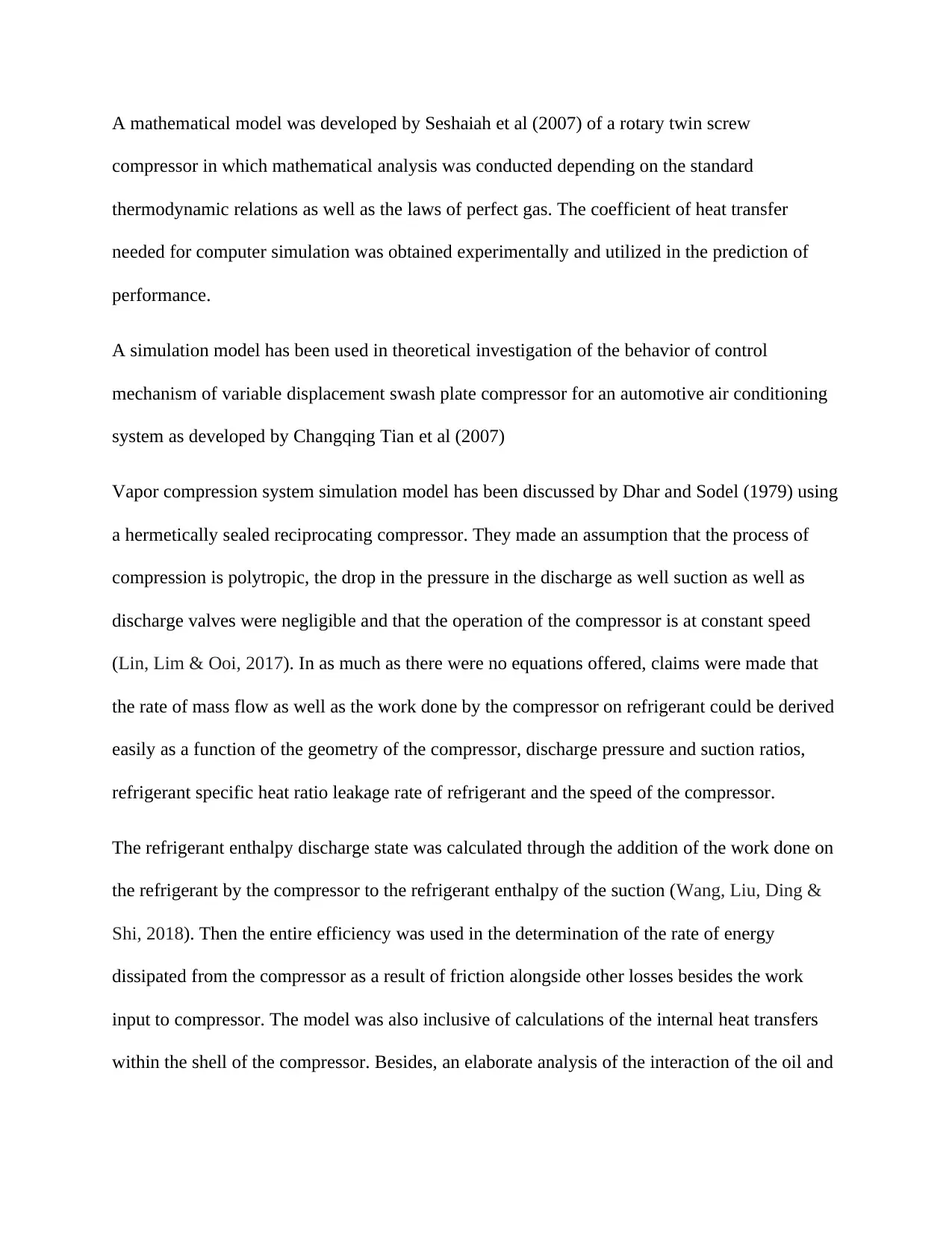
A mathematical model was developed by Seshaiah et al (2007) of a rotary twin screw
compressor in which mathematical analysis was conducted depending on the standard
thermodynamic relations as well as the laws of perfect gas. The coefficient of heat transfer
needed for computer simulation was obtained experimentally and utilized in the prediction of
performance.
A simulation model has been used in theoretical investigation of the behavior of control
mechanism of variable displacement swash plate compressor for an automotive air conditioning
system as developed by Changqing Tian et al (2007)
Vapor compression system simulation model has been discussed by Dhar and Sodel (1979) using
a hermetically sealed reciprocating compressor. They made an assumption that the process of
compression is polytropic, the drop in the pressure in the discharge as well suction as well as
discharge valves were negligible and that the operation of the compressor is at constant speed
(Lin, Lim & Ooi, 2017). In as much as there were no equations offered, claims were made that
the rate of mass flow as well as the work done by the compressor on refrigerant could be derived
easily as a function of the geometry of the compressor, discharge pressure and suction ratios,
refrigerant specific heat ratio leakage rate of refrigerant and the speed of the compressor.
The refrigerant enthalpy discharge state was calculated through the addition of the work done on
the refrigerant by the compressor to the refrigerant enthalpy of the suction (Wang, Liu, Ding &
Shi, 2018). Then the entire efficiency was used in the determination of the rate of energy
dissipated from the compressor as a result of friction alongside other losses besides the work
input to compressor. The model was also inclusive of calculations of the internal heat transfers
within the shell of the compressor. Besides, an elaborate analysis of the interaction of the oil and
compressor in which mathematical analysis was conducted depending on the standard
thermodynamic relations as well as the laws of perfect gas. The coefficient of heat transfer
needed for computer simulation was obtained experimentally and utilized in the prediction of
performance.
A simulation model has been used in theoretical investigation of the behavior of control
mechanism of variable displacement swash plate compressor for an automotive air conditioning
system as developed by Changqing Tian et al (2007)
Vapor compression system simulation model has been discussed by Dhar and Sodel (1979) using
a hermetically sealed reciprocating compressor. They made an assumption that the process of
compression is polytropic, the drop in the pressure in the discharge as well suction as well as
discharge valves were negligible and that the operation of the compressor is at constant speed
(Lin, Lim & Ooi, 2017). In as much as there were no equations offered, claims were made that
the rate of mass flow as well as the work done by the compressor on refrigerant could be derived
easily as a function of the geometry of the compressor, discharge pressure and suction ratios,
refrigerant specific heat ratio leakage rate of refrigerant and the speed of the compressor.
The refrigerant enthalpy discharge state was calculated through the addition of the work done on
the refrigerant by the compressor to the refrigerant enthalpy of the suction (Wang, Liu, Ding &
Shi, 2018). Then the entire efficiency was used in the determination of the rate of energy
dissipated from the compressor as a result of friction alongside other losses besides the work
input to compressor. The model was also inclusive of calculations of the internal heat transfers
within the shell of the compressor. Besides, an elaborate analysis of the interaction of the oil and
Paraphrase This Document
Need a fresh take? Get an instant paraphrase of this document with our AI Paraphraser
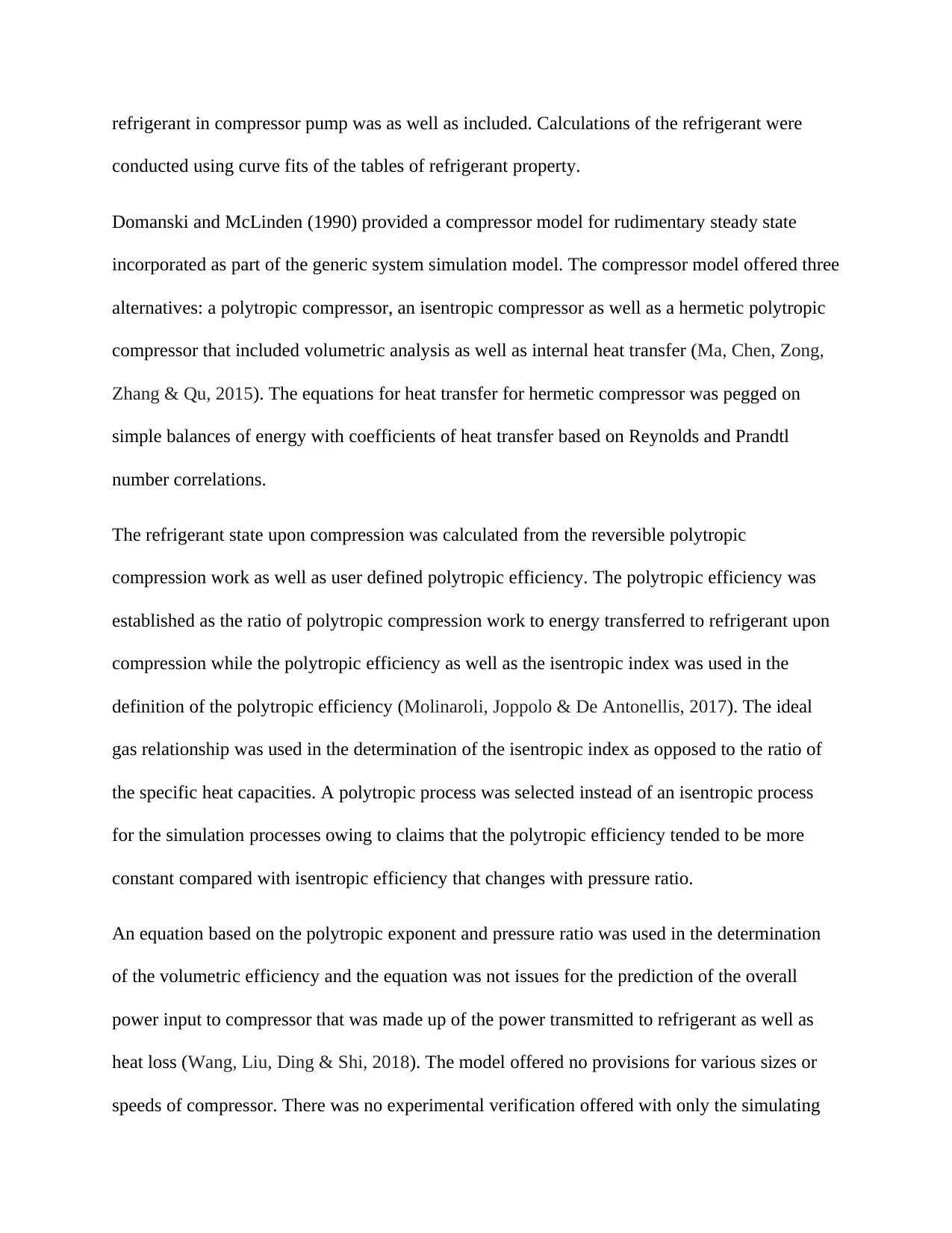
refrigerant in compressor pump was as well as included. Calculations of the refrigerant were
conducted using curve fits of the tables of refrigerant property.
Domanski and McLinden (1990) provided a compressor model for rudimentary steady state
incorporated as part of the generic system simulation model. The compressor model offered three
alternatives: a polytropic compressor, an isentropic compressor as well as a hermetic polytropic
compressor that included volumetric analysis as well as internal heat transfer (Ma, Chen, Zong,
Zhang & Qu, 2015). The equations for heat transfer for hermetic compressor was pegged on
simple balances of energy with coefficients of heat transfer based on Reynolds and Prandtl
number correlations.
The refrigerant state upon compression was calculated from the reversible polytropic
compression work as well as user defined polytropic efficiency. The polytropic efficiency was
established as the ratio of polytropic compression work to energy transferred to refrigerant upon
compression while the polytropic efficiency as well as the isentropic index was used in the
definition of the polytropic efficiency (Molinaroli, Joppolo & De Antonellis, 2017). The ideal
gas relationship was used in the determination of the isentropic index as opposed to the ratio of
the specific heat capacities. A polytropic process was selected instead of an isentropic process
for the simulation processes owing to claims that the polytropic efficiency tended to be more
constant compared with isentropic efficiency that changes with pressure ratio.
An equation based on the polytropic exponent and pressure ratio was used in the determination
of the volumetric efficiency and the equation was not issues for the prediction of the overall
power input to compressor that was made up of the power transmitted to refrigerant as well as
heat loss (Wang, Liu, Ding & Shi, 2018). The model offered no provisions for various sizes or
speeds of compressor. There was no experimental verification offered with only the simulating
conducted using curve fits of the tables of refrigerant property.
Domanski and McLinden (1990) provided a compressor model for rudimentary steady state
incorporated as part of the generic system simulation model. The compressor model offered three
alternatives: a polytropic compressor, an isentropic compressor as well as a hermetic polytropic
compressor that included volumetric analysis as well as internal heat transfer (Ma, Chen, Zong,
Zhang & Qu, 2015). The equations for heat transfer for hermetic compressor was pegged on
simple balances of energy with coefficients of heat transfer based on Reynolds and Prandtl
number correlations.
The refrigerant state upon compression was calculated from the reversible polytropic
compression work as well as user defined polytropic efficiency. The polytropic efficiency was
established as the ratio of polytropic compression work to energy transferred to refrigerant upon
compression while the polytropic efficiency as well as the isentropic index was used in the
definition of the polytropic efficiency (Molinaroli, Joppolo & De Antonellis, 2017). The ideal
gas relationship was used in the determination of the isentropic index as opposed to the ratio of
the specific heat capacities. A polytropic process was selected instead of an isentropic process
for the simulation processes owing to claims that the polytropic efficiency tended to be more
constant compared with isentropic efficiency that changes with pressure ratio.
An equation based on the polytropic exponent and pressure ratio was used in the determination
of the volumetric efficiency and the equation was not issues for the prediction of the overall
power input to compressor that was made up of the power transmitted to refrigerant as well as
heat loss (Wang, Liu, Ding & Shi, 2018). The model offered no provisions for various sizes or
speeds of compressor. There was no experimental verification offered with only the simulating
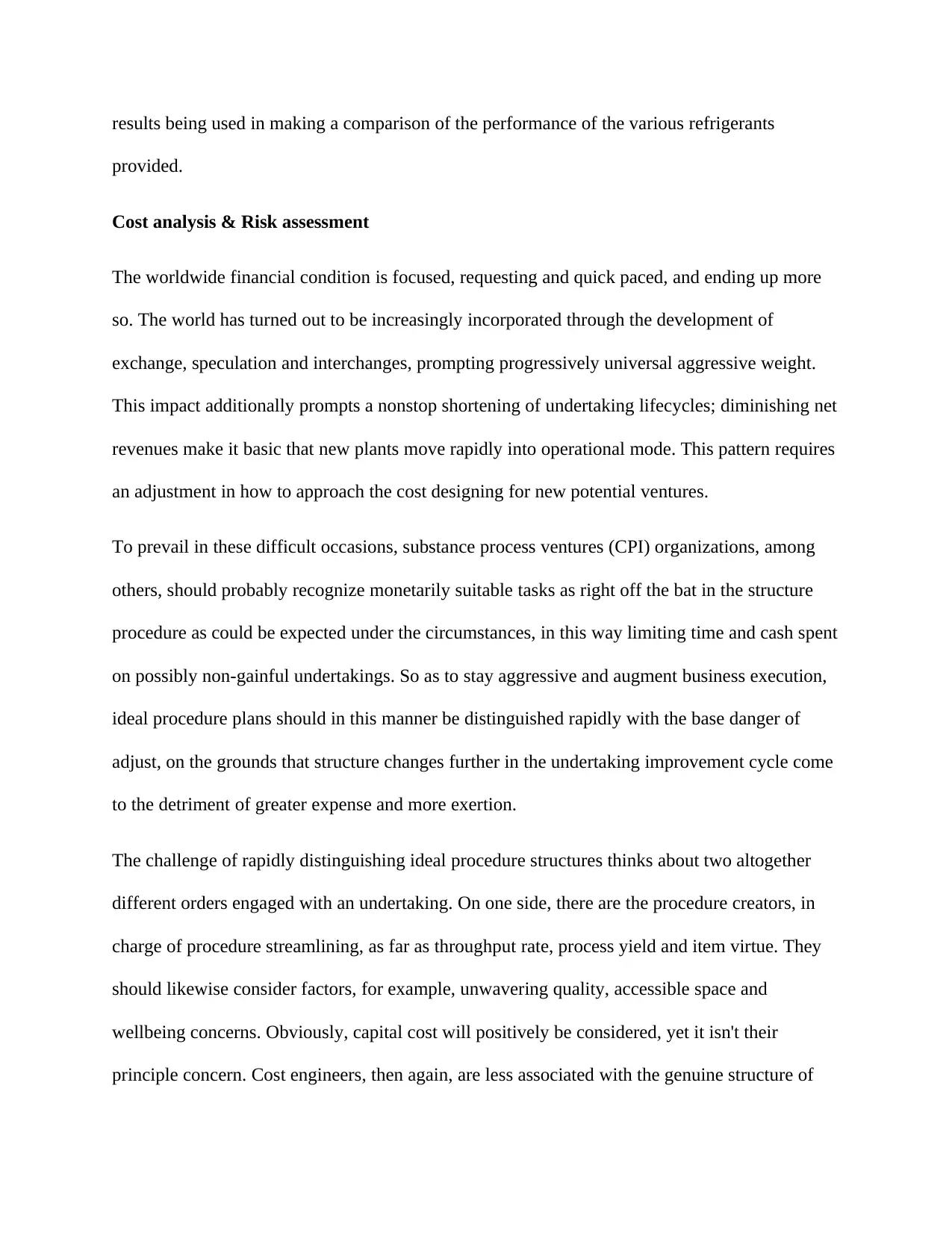
results being used in making a comparison of the performance of the various refrigerants
provided.
Cost analysis & Risk assessment
The worldwide financial condition is focused, requesting and quick paced, and ending up more
so. The world has turned out to be increasingly incorporated through the development of
exchange, speculation and interchanges, prompting progressively universal aggressive weight.
This impact additionally prompts a nonstop shortening of undertaking lifecycles; diminishing net
revenues make it basic that new plants move rapidly into operational mode. This pattern requires
an adjustment in how to approach the cost designing for new potential ventures.
To prevail in these difficult occasions, substance process ventures (CPI) organizations, among
others, should probably recognize monetarily suitable tasks as right off the bat in the structure
procedure as could be expected under the circumstances, in this way limiting time and cash spent
on possibly non-gainful undertakings. So as to stay aggressive and augment business execution,
ideal procedure plans should in this manner be distinguished rapidly with the base danger of
adjust, on the grounds that structure changes further in the undertaking improvement cycle come
to the detriment of greater expense and more exertion.
The challenge of rapidly distinguishing ideal procedure structures thinks about two altogether
different orders engaged with an undertaking. On one side, there are the procedure creators, in
charge of procedure streamlining, as far as throughput rate, process yield and item virtue. They
should likewise consider factors, for example, unwavering quality, accessible space and
wellbeing concerns. Obviously, capital cost will positively be considered, yet it isn't their
principle concern. Cost engineers, then again, are less associated with the genuine structure of
provided.
Cost analysis & Risk assessment
The worldwide financial condition is focused, requesting and quick paced, and ending up more
so. The world has turned out to be increasingly incorporated through the development of
exchange, speculation and interchanges, prompting progressively universal aggressive weight.
This impact additionally prompts a nonstop shortening of undertaking lifecycles; diminishing net
revenues make it basic that new plants move rapidly into operational mode. This pattern requires
an adjustment in how to approach the cost designing for new potential ventures.
To prevail in these difficult occasions, substance process ventures (CPI) organizations, among
others, should probably recognize monetarily suitable tasks as right off the bat in the structure
procedure as could be expected under the circumstances, in this way limiting time and cash spent
on possibly non-gainful undertakings. So as to stay aggressive and augment business execution,
ideal procedure plans should in this manner be distinguished rapidly with the base danger of
adjust, on the grounds that structure changes further in the undertaking improvement cycle come
to the detriment of greater expense and more exertion.
The challenge of rapidly distinguishing ideal procedure structures thinks about two altogether
different orders engaged with an undertaking. On one side, there are the procedure creators, in
charge of procedure streamlining, as far as throughput rate, process yield and item virtue. They
should likewise consider factors, for example, unwavering quality, accessible space and
wellbeing concerns. Obviously, capital cost will positively be considered, yet it isn't their
principle concern. Cost engineers, then again, are less associated with the genuine structure of
⊘ This is a preview!⊘
Do you want full access?
Subscribe today to unlock all pages.

Trusted by 1+ million students worldwide
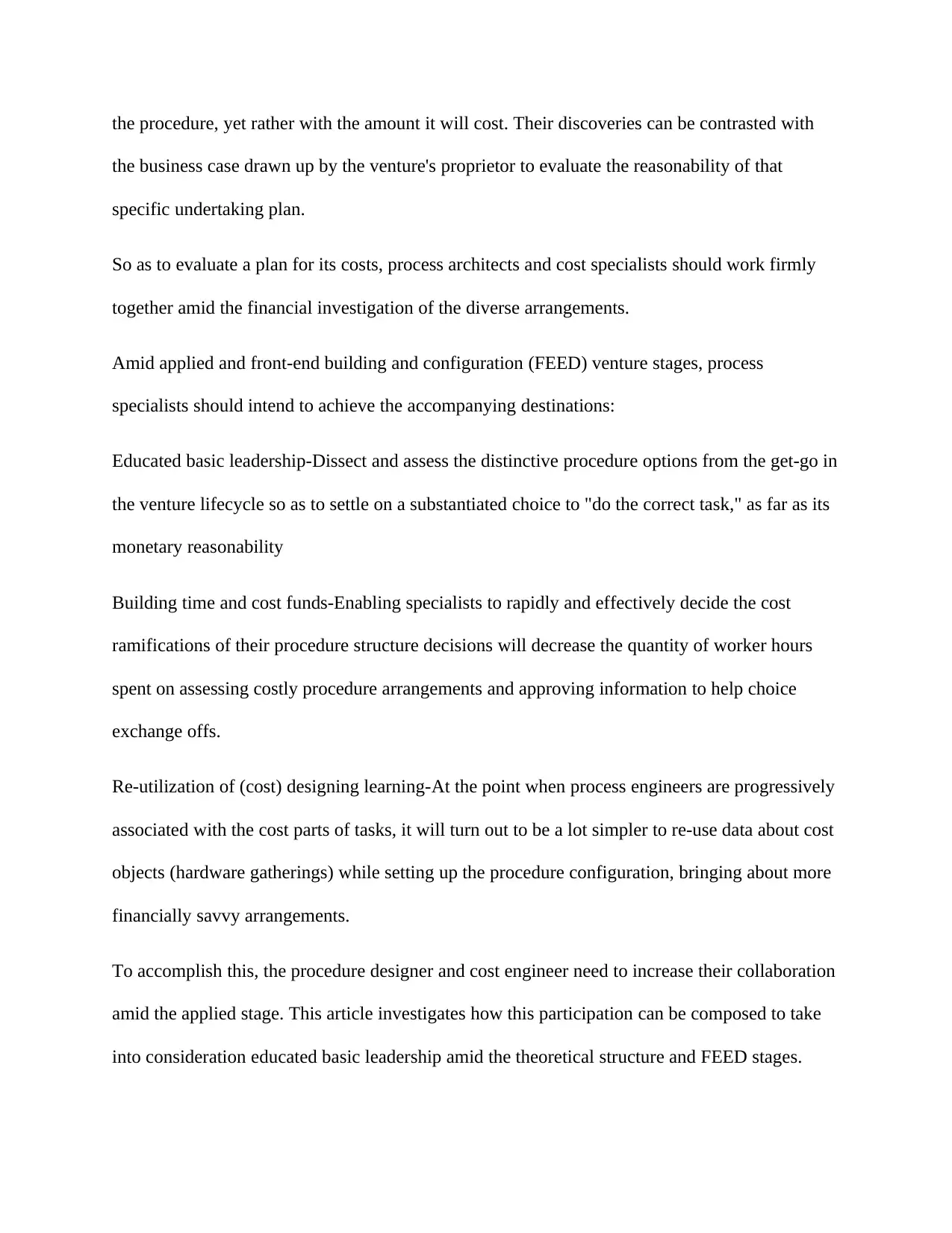
the procedure, yet rather with the amount it will cost. Their discoveries can be contrasted with
the business case drawn up by the venture's proprietor to evaluate the reasonability of that
specific undertaking plan.
So as to evaluate a plan for its costs, process architects and cost specialists should work firmly
together amid the financial investigation of the diverse arrangements.
Amid applied and front-end building and configuration (FEED) venture stages, process
specialists should intend to achieve the accompanying destinations:
Educated basic leadership-Dissect and assess the distinctive procedure options from the get-go in
the venture lifecycle so as to settle on a substantiated choice to "do the correct task," as far as its
monetary reasonability
Building time and cost funds-Enabling specialists to rapidly and effectively decide the cost
ramifications of their procedure structure decisions will decrease the quantity of worker hours
spent on assessing costly procedure arrangements and approving information to help choice
exchange offs.
Re-utilization of (cost) designing learning-At the point when process engineers are progressively
associated with the cost parts of tasks, it will turn out to be a lot simpler to re-use data about cost
objects (hardware gatherings) while setting up the procedure configuration, bringing about more
financially savvy arrangements.
To accomplish this, the procedure designer and cost engineer need to increase their collaboration
amid the applied stage. This article investigates how this participation can be composed to take
into consideration educated basic leadership amid the theoretical structure and FEED stages.
the business case drawn up by the venture's proprietor to evaluate the reasonability of that
specific undertaking plan.
So as to evaluate a plan for its costs, process architects and cost specialists should work firmly
together amid the financial investigation of the diverse arrangements.
Amid applied and front-end building and configuration (FEED) venture stages, process
specialists should intend to achieve the accompanying destinations:
Educated basic leadership-Dissect and assess the distinctive procedure options from the get-go in
the venture lifecycle so as to settle on a substantiated choice to "do the correct task," as far as its
monetary reasonability
Building time and cost funds-Enabling specialists to rapidly and effectively decide the cost
ramifications of their procedure structure decisions will decrease the quantity of worker hours
spent on assessing costly procedure arrangements and approving information to help choice
exchange offs.
Re-utilization of (cost) designing learning-At the point when process engineers are progressively
associated with the cost parts of tasks, it will turn out to be a lot simpler to re-use data about cost
objects (hardware gatherings) while setting up the procedure configuration, bringing about more
financially savvy arrangements.
To accomplish this, the procedure designer and cost engineer need to increase their collaboration
amid the applied stage. This article investigates how this participation can be composed to take
into consideration educated basic leadership amid the theoretical structure and FEED stages.
Paraphrase This Document
Need a fresh take? Get an instant paraphrase of this document with our AI Paraphraser

Failure mode and effect analysis (FMEA)
A failure mode and impact examination or FMEA so, is a building system used to characterize,
recognize, and dispose of known and additionally potential disappointments, issues, mistakes, so
on from the framework configuration, process, and/or administration before they achieve the
client. [SJ This system is generally being utilized in numerous orders adequately, and there is no
motivation behind why this idea can't be connected in managing with the phenomenal
circumstances.
Risk Priority Number (RPN)
Finding the need is significant and the pushed of the technique. There are three segments that
assistance characterize the need of disappointments; Occurrence, Severity, and Detection. Event
is the recurrence of the failure.[5J Severity is the earnestness (impacts) of the disappointment.
Location is the capacity to identify the disappointment before it achieves the clients. Among a
few different ways to characterize the estimation of these segments, one route is to utilize
subjective numerical scale. A decent FMEA organizes the distinguished disappointment modes
as indicated by the hazard need number (RPN). This number is the result of recurrence of event,
seriousness, and location. This RPN number is utilized just to rank request. In understanding to a
proposed subjective numerical scale 1 to 10 for event, seriousness and location
Economic consideration
The 'principal cost' of a given is dependably a main factor while choosing one model over
another. First expense is influenced by numerous variables, similar to configuration, weight and
stream, greased up or sans (oil-less) and any exceptional highlights that might be required. As a
rule, revolving screw and outward blowers will in general be more costly than responding
A failure mode and impact examination or FMEA so, is a building system used to characterize,
recognize, and dispose of known and additionally potential disappointments, issues, mistakes, so
on from the framework configuration, process, and/or administration before they achieve the
client. [SJ This system is generally being utilized in numerous orders adequately, and there is no
motivation behind why this idea can't be connected in managing with the phenomenal
circumstances.
Risk Priority Number (RPN)
Finding the need is significant and the pushed of the technique. There are three segments that
assistance characterize the need of disappointments; Occurrence, Severity, and Detection. Event
is the recurrence of the failure.[5J Severity is the earnestness (impacts) of the disappointment.
Location is the capacity to identify the disappointment before it achieves the clients. Among a
few different ways to characterize the estimation of these segments, one route is to utilize
subjective numerical scale. A decent FMEA organizes the distinguished disappointment modes
as indicated by the hazard need number (RPN). This number is the result of recurrence of event,
seriousness, and location. This RPN number is utilized just to rank request. In understanding to a
proposed subjective numerical scale 1 to 10 for event, seriousness and location
Economic consideration
The 'principal cost' of a given is dependably a main factor while choosing one model over
another. First expense is influenced by numerous variables, similar to configuration, weight and
stream, greased up or sans (oil-less) and any exceptional highlights that might be required. As a
rule, revolving screw and outward blowers will in general be more costly than responding
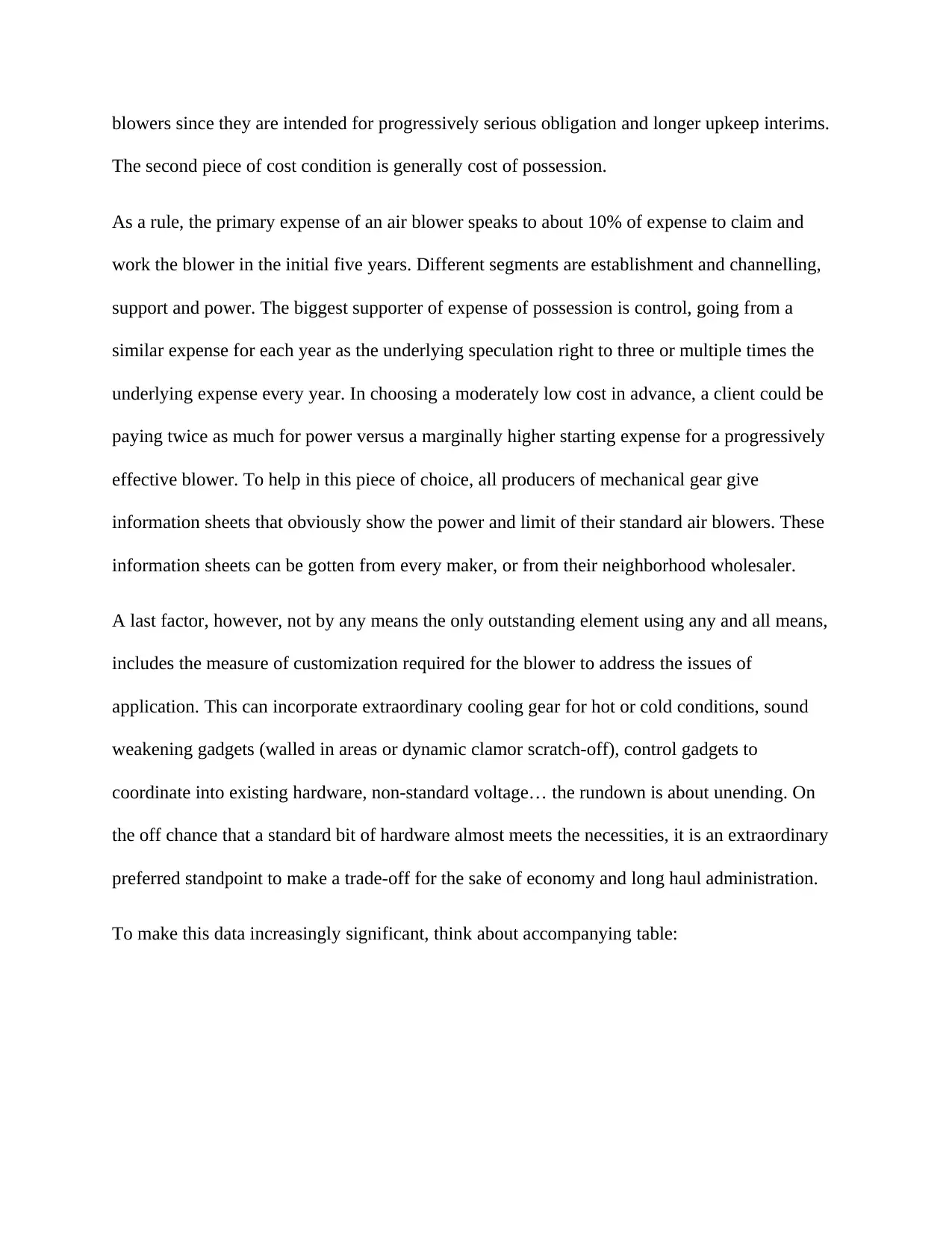
blowers since they are intended for progressively serious obligation and longer upkeep interims.
The second piece of cost condition is generally cost of possession.
As a rule, the primary expense of an air blower speaks to about 10% of expense to claim and
work the blower in the initial five years. Different segments are establishment and channelling,
support and power. The biggest supporter of expense of possession is control, going from a
similar expense for each year as the underlying speculation right to three or multiple times the
underlying expense every year. In choosing a moderately low cost in advance, a client could be
paying twice as much for power versus a marginally higher starting expense for a progressively
effective blower. To help in this piece of choice, all producers of mechanical gear give
information sheets that obviously show the power and limit of their standard air blowers. These
information sheets can be gotten from every maker, or from their neighborhood wholesaler.
A last factor, however, not by any means the only outstanding element using any and all means,
includes the measure of customization required for the blower to address the issues of
application. This can incorporate extraordinary cooling gear for hot or cold conditions, sound
weakening gadgets (walled in areas or dynamic clamor scratch-off), control gadgets to
coordinate into existing hardware, non-standard voltage… the rundown is about unending. On
the off chance that a standard bit of hardware almost meets the necessities, it is an extraordinary
preferred standpoint to make a trade-off for the sake of economy and long haul administration.
To make this data increasingly significant, think about accompanying table:
The second piece of cost condition is generally cost of possession.
As a rule, the primary expense of an air blower speaks to about 10% of expense to claim and
work the blower in the initial five years. Different segments are establishment and channelling,
support and power. The biggest supporter of expense of possession is control, going from a
similar expense for each year as the underlying speculation right to three or multiple times the
underlying expense every year. In choosing a moderately low cost in advance, a client could be
paying twice as much for power versus a marginally higher starting expense for a progressively
effective blower. To help in this piece of choice, all producers of mechanical gear give
information sheets that obviously show the power and limit of their standard air blowers. These
information sheets can be gotten from every maker, or from their neighborhood wholesaler.
A last factor, however, not by any means the only outstanding element using any and all means,
includes the measure of customization required for the blower to address the issues of
application. This can incorporate extraordinary cooling gear for hot or cold conditions, sound
weakening gadgets (walled in areas or dynamic clamor scratch-off), control gadgets to
coordinate into existing hardware, non-standard voltage… the rundown is about unending. On
the off chance that a standard bit of hardware almost meets the necessities, it is an extraordinary
preferred standpoint to make a trade-off for the sake of economy and long haul administration.
To make this data increasingly significant, think about accompanying table:
⊘ This is a preview!⊘
Do you want full access?
Subscribe today to unlock all pages.

Trusted by 1+ million students worldwide
1 out of 21
Your All-in-One AI-Powered Toolkit for Academic Success.
+13062052269
info@desklib.com
Available 24*7 on WhatsApp / Email
![[object Object]](/_next/static/media/star-bottom.7253800d.svg)
Unlock your academic potential
Copyright © 2020–2025 A2Z Services. All Rights Reserved. Developed and managed by ZUCOL.